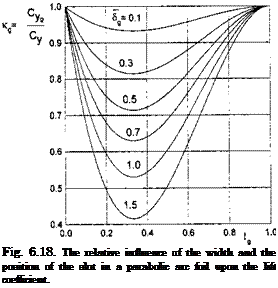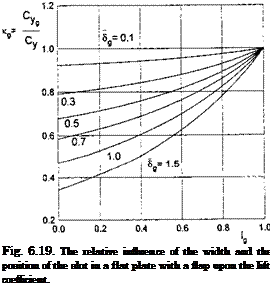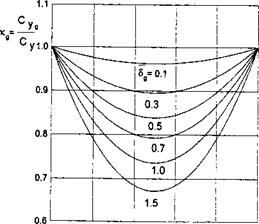Slotted Wings in the Ground Effect
When the lifting surface is slotted, the same formalism can be applied to account for the influence of gaps upon its aerodynamics in the ground effect. As indicated in Durand (1934), the problem of the slotted wing is of practical importance for several reasons. In the case of lateral slots with a proper choice of the adjusted angles of attack of portions of the wing, separated by the slots, a better lifting capacity can be achieved. On the other hand, introduction of longitudinal slots especially near the root section of the lifting surface, can result in an increase in induced drag.
It should be mentioned that numerical solutions of the flow problem for a wing with narrow slots can bring about computational difficulties and even divergence of the computational processes. In any case the number of control points should be considerably increased in the immediate vicinity of the gap to avoid numerical errors.
An exact solution for a two-dimensional foil with one small gap in an unbounded fluid was developed by Chaplygin. Bleviss and Strubble [145] obtained some exact solutions for longitudinal gaps on a wing of small aspect ratio in unbounded flow. Application of the method of matched asymptotic expansions opens certain possibilities for a simplified analysis of the flow problems for slotted wings both in and out of the ground effect. White and Landahl [146] handled corresponding 2-D problems by the matched asymptotics technique. In what follows, we use the asymptotic theory set forth in previous sections of this book to evaluate the influence of a lateral gap of small width 5g = 5gh, 5g = 0(1), located at a distance lg = 0(1) from the trailing edge, upon the aerodynamic characteristics of a thin rectangular wing of aspect ratio Л, moving at very small distances from the ground h <C 1; see Rozhdestvensky [45, 46].
As discussed previously, to account for the influence of the gap, we have to analyze the local flow near it, find the corresponding asymptotic solution, and subsequently, match it to the main flow. This procedure can be shown to be applicable in nonlinear case, but here analysis will be limited to a the linearized case. In compliance with the linear theory it will be assumed that the vortex sheet emanating from the leading edge of the lateral gap stays in the same horizontal plane. Sufficiently far from the intersection of the slot with the side edges of the wing, we will consider the local flow as a two-dimensional flow in the planes z = const, which are normal to the gap’s axis. Near the gap, the local stretched coordinates yg = y/h, xg = xg/h = (x — l)/h, zg — z are introduced. In the plane of the complex variable Z = xg + iyg, the complex velocity potential Fg and the complex conjugate velocity
dFg.
g dZ g g
of the flow near the gap are analytic functions, satisfying the following boundary conditions:
• on the ground {yg = 0 + 0),
a) 3Fg = = 0, b) ^swg = —vg = 0; (6.161)
• on the wing behind the gap (yg = 1 ± 0, xg < —Sg/2),
a) $sFg = ipg = l, b) ^swg = —vg — has{lg – f 0, г, £); (6.162)
• on the wing in front of the gap (yg = 1 ± 0, xg > <$g/2),
a) QFg = = 7g, b) Sfri;g = — ug = has(lg ± 0, z, t). (6.163)
Here 7g is an unknown constant associated with the rate of the fluid passing through the gap;
_ dys dys
as dx dt
is a prescribed downwash near the leading and trailing edges of the gap. The superscripts plus and minus correspond to points on the upper and lower surfaces of the wing, respectively. According to the scheme already discussed above, the gap flow solution will be decomposed into (a) homogeneous and (b) nonhomogeneous solutions. To proceed with the solution of the local problem, formulated above, we map the flow region onto an upper half plane of the auxiliary complex plane. The point-to-point correspondence is shown in Fig. 6.15.
 |
|
The mapping function was obtained by application of the Christoffel – Schwartz integral
Note that for sufficiently small 6g < 0.5, we can approximately set (3 = 7r<Sg/8. The solution of problem (a) was found in the form
Fag = I (in + 7g In ^I). (6.166)
It is easy to verify that this solution does not violate the flow tangency condition at points on the wing. The velocity potential on the surface of the wing is calculated by taking the real part of the complex potential and setting C — 6 Then,
V>ag = 1 (in фф + 7g In • (6.167)
The solution of problem (b) was found with help of the Schwartz integral for a half plane, which enables us to construct an analytic function by using its imaginary part, given on the real axis; see Fuks and Shabat [131]:
![]()
![]()
![]()

dCi + C
|
V5 bg |

Omitting the real constant C and separating the real part of expression (6.168), for points on the surface of the wing near the gap,
![]() <Pg — ^l^ag ^2^bg d – khxg – j – ^4?
<Pg — ^l^ag ^2^bg d – khxg – j – ^4?
where parameters li must be determined by matching procedures. Parameters /з and Z4 take different values above (yg = 1 + 0) and below (yg = 1 — 0) the gap, that is ф l% and 1% ф 14 . The real constant 7g was found by accounting for the requirement that the perturbation velocity should be finite at the leading edge of the gap (point C in Fig. 6.15 ) as
![]() _l-(3 7g~ ! + /?•
_l-(3 7g~ ! + /?•
It can be readily demonstrated that for such a choice of 7g, the perturbation velocity at the trailing edge of the gap (point В in Fig. 6.15) has a square
root singularity, i. e., behaves as s~1^2 (where s is the distance of the point from the trailing edge of the gap in the downstream direction). Asymptotic representations of the gap velocity potential (6.167) far from the gap, which are needed for matching with the main flow solution, can be written as follows:
• far from the gap on the upper surface of the wing (у = 1 + 0),
, 7r(l – /32)xg
n(l + /3) n 2(32
{as) otgi’lg 0) 0).
|
‘ 2/З2 і ‘j = *^g (<*s> 2 (^g 0) — ^2 J j H – hhxg H-14) %g ^ Vg = 1 A? |
• Far from the gap upon the lower surface of the wing (yg = 1 — 0),
: (as) In2 + as(/g ~ °) 1 ] } + hhxg + /4,
![]() Xg —>• —00, yg = 1 — 0.
Xg —>• —00, yg = 1 — 0.
The velocity potentials of the upper flow, channel flow, and leading and trailing edge flows can be constructed in a manner explained in detail in previous sections. For briefness we discuss only the changes to be introduced into the procedure for solution when the wing has a lateral gap.
The upper flow potential in region Vu is represented by a straightforward distribution of sources (sinks) over the projection of the wing plus the wake onto the ground with the addition of the admissible contour distribution of the sources (sinks) along the edges of the wing (wake) and along the axis of the gap. Expression (2.31) of section 2 for the upper flow potential should be supplemented by the term
-jzl dzo, rg = J(x-le)2 + (z – z0)2, (6.175)
47r J-/2 rg V
which represents the potential of a linear distribution of the sources (sinks) with a strength Qg and models (in the upper flow region) a leakage of the fluid through the gap from beneath the wing. The strength Qg of the singularity
distribution has to be determined by matching with the gap flow potential <pg.
Taking into account expression (6.175), the asymptotic representation of the upper flow potential near the gap is found in the form
Here, parameters L and L<i characterize the influence of distant sources (sinks). Corresponding expressions for are not presented herein for briefness.
The channel flow potential satisfies the same Poisson equation as that for the wing without slots. However, this equation, strictly speaking, has to be solved separately in two portions of the wing planform divided by the gap axis. The boundary conditions at the leading (side) and trailing edges of the wing are given by the same formulas as previously discussed. The only difference is that the constants A2,i? i, and B2 comprise contributions from the additional term (6.175) in the expression of the upper potential.
A special feature of the channel flow for a slotted wing is that both values of the potential <p and the corresponding pressures are, generally speaking, different when one approaches the line x = lg,z < A/2 from the left and from the right. Physically, this is connected with mass and vorticity transport through the gap. Rewriting expressions (6.174) and (6.176) in terms of the gap variable xg = hxg enables us to find asymptotic structure of the parameter 11 when xg tends to 0 + 0 and 0 — 0:
 |
Some results, calculated by using formulas (6.196) when the gap is located at the midchord of the plate (lg — 0.5) for different h and 6„ are given in Fig. 6.16.
As seen from this figure, within the range of clearances under consideration, the presence of the gap brings along a certain reduction of the lift and moment coefficients.5
Analysis of calculations of the factors ks and кт for different 0 < h < 0.12 shows that these quantities are only weakly dependent on the relative clearance. The latter circumstance provides a sound basis for using much simpler formulas, using leading order contributions (6.192) and (6.193). In particular cases, these expressions take the following forms:
• flat plate:
• flat plate with a flap f(x) = x for 0 < x < bf, f(x) = 0 for bf < x < 1, where bf is the chord of the flap. When the gap is located near the hinge of the flap, Zg = bf,
![]() 4/?(l ~ bf) 60(1-bf)
4/?(l ~ bf) 60(1-bf)
(1 + /3)(2 — b{) ’ m (l + /?)(3-b?)-
 |
|
It follows from the expressions for Kg and кт that for a foil with a given camberline /(rr), a position of the gap exists for which the decrease of the aerodynamic coefficients due to the gap is most pronounced. For example, for a flat plate, the minimum of Kg is reached at /g = 0.5, whereas for an arc foil, this minimum is achieved at Z = 1/3. Figures 6.17-6.19 illustrate some results for ttg. It can be seen from analysis of the figures that the influence of the gap for a given width 5g and location lg depends on the shape of the camber line. For example, at lg = 0.5 and 6g = 0.3 for a flat plate, Kg = 0.9, whereas for a plate with a flap and lg = bf = 0.5, Kg = 0.85.
![]()
Ri = ^2 9n [tanh(9„ig) + tanh tanh(gn/g)
n=о L 2 J qn
![]()
|
 |
 |
g W«anh*,_ s
£o«*v «» ‘
_ tanh[g„(l – lg)]
Sn q* coshgn[l + (1 – /3) tanh(qnig) tanh(l – lg)/( 1 + /3)]’
qn = ^(2n+ 1).
Some calculated results using formulas (6.201) and (6.202) are given in Table 6.1 for lg = 0.5 and 5g = 0.3.
These data demonstrate that the influence of the lateral gap upon the aerodynamic coefficients diminishes quite noticeably with a decrease in the aspect ratio.
|
Table 6.1 The influence of a lateral slot upon the lift and moment of a rectangular wing in the extreme ground effect.
|












